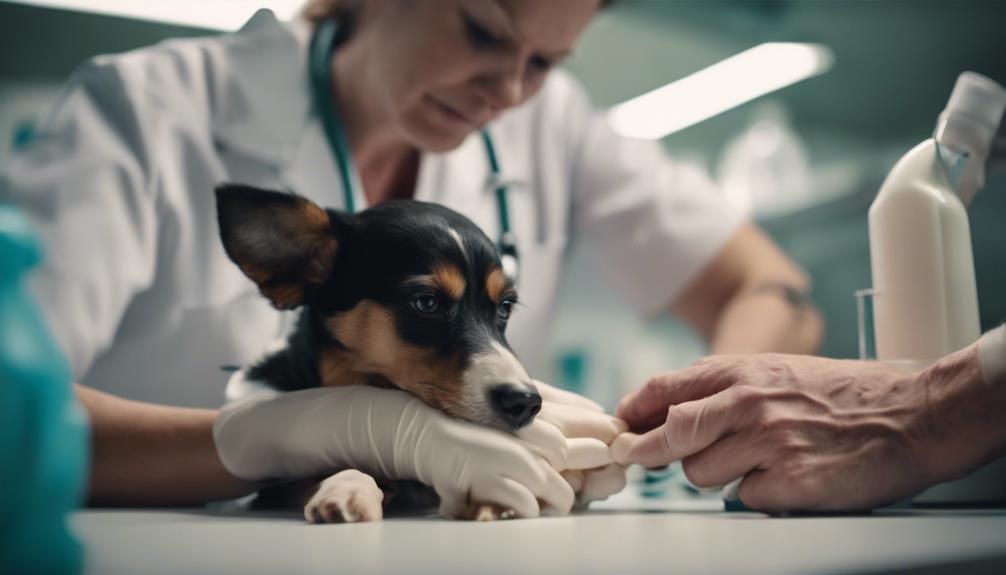Mastitis in nursing dogs presents a complex array of symptoms that can be easily overlooked in its initial stages. While mild swelling and discomfort may serve as early indicators, the progression of this condition unveils more alarming signs that necessitate prompt attention. Understanding these subtle cues and knowing how to respond effectively are crucial aspects of supporting the well-being of your nursing dog.
By recognizing the surprising signs of mastitis and implementing appropriate interventions, dog owners can play a pivotal role in helping their companions navigate through this challenging health issue.
Key Takeaways
- Early signs of mastitis in nursing dogs include pups not gaining weight and mild swelling.
- Severe mastitis can present with ulceration, pain, anorexia, and dehydration.
- Treatment for mastitis involves antibiotics, pain relief, and possibly surgical removal.
- Prevention includes keeping bedding clean, equal nursing, and regular breast hygiene.
Common Causes of Mastitis in Dogs
Common causes of mastitis in dogs often stem from bacterial infections. This is predominantly attributed to Escherichia coli, Staphylococcus sp., or Streptococcus sp., entering the mammary glands through nipple trauma or unhygienic birthing environments. These bacteria can proliferate rapidly in the warm, moist environment of the mammary glands, leading to inflammation and infection.
Nipple trauma caused by rough nursing behavior or inadequate hygiene practices during birth can create entry points for these bacteria. It is crucial for dog owners to ensure clean and sanitary birthing environments, regularly inspect nipples for any signs of damage, and promptly address any issues to prevent the development of mastitis in their nursing dogs.
Early detection and proper management are key in preventing complications associated with mastitis.
Early Signs to Watch For
Detecting mastitis in dogs early is crucial for prompt intervention and successful treatment. Early signs to watch for include puppies not gaining weight as expected, mild swelling in the mammary glands, and signs of discomfort in the nursing dog.
It is essential to monitor the nursing process closely to identify any abnormalities in the nursing behavior or physical symptoms in the mother dog. Any deviation from the normal nursing routine or appearance of the mammary glands should raise concerns and prompt further investigation.
Progressing Symptoms to Recognize

As the initial signs of mastitis in dogs progress, it is crucial to recognize evolving symptoms that indicate a worsening condition requiring immediate attention and intervention. These progressing symptoms may include decreased milk production, changes in milk appearance, or the presence of blood or pus in the milk. It is essential for dog owners to monitor their nursing dogs closely for these signs to ensure prompt treatment and prevent severe complications.
| Symptom | Description | Action Required |
|---|---|---|
| Decreased milk production | Reduction in the amount of milk produced | Veterinary consultation |
| Changes in milk appearance | Altered color, consistency, or texture of milk | Veterinary evaluation |
| Blood or pus in the milk | Presence of blood streaks or pus in the milk | Immediate veterinary attention |
Severe Mastitis Warning Signs
Early detection of severe mastitis in dogs is crucial for timely intervention and successful management of the condition. Severe mastitis presents with noticeable warning signs including ulceration, swollen, warm, red or purple, painful breasts, vomiting, lethargy, anorexia, fever, dehydration, shock, and weight loss.
These symptoms indicate a more advanced and potentially life-threatening stage of mastitis that requires immediate attention from a veterinarian. Prompt recognition of these severe signs can help prevent complications and improve the chances of recovery for the nursing dog.
Monitoring the nursing dog closely for these warning signs is essential to ensure the well-being of both the mother and her puppies during this challenging time.
Diagnosis and Testing Methods

To ensure accurate diagnosis and effective management of mastitis in dogs, veterinary professionals employ various diagnostic methods and testing procedures. Diagnostic steps may include:
- Conducting a thorough physical examination of the mammary glands and surrounding areas.
- Obtaining a detailed history from the dog owner regarding the onset of symptoms and any recent changes in the dog's nursing behavior.
- Performing milk expression and microscopic examination to check for the presence of bacteria or other abnormalities.
- Utilizing milk culture to identify the specific bacteria causing the infection.
- Carrying out bloodwork to assess if the infection has spread systemically and to monitor the dog's overall health status during treatment.
Effective Home Treatments
Home treatments for mastitis in dogs can be effective in managing mild to moderate cases of the condition. These treatments can help alleviate discomfort and support the healing process. Below is a simple table outlining some effective home remedies for mastitis in dogs:
| Home Remedies | Description |
|---|---|
| Warm Compress | Applying a warm compress to the affected area can help reduce swelling and promote milk flow. |
| Epsom Salt Soaks | Epsom salt soaks can aid in reducing inflammation and keeping the area clean. |
| Herbal Remedies | Certain herbs like chamomile or calendula can have anti-inflammatory properties when applied topically. |
Preventive Measures for Mastitis

Implementing proper hygiene practices is essential in reducing the risk of mastitis in dogs. To prevent this painful condition in nursing dogs, consider the following preventive measures:
- Regularly clean and sanitize the whelping area to prevent bacterial contamination.
- Ensure puppies latch onto nipples properly to avoid milk accumulation and engorgement.
- Monitor the mother's mammary glands for any signs of inflammation to catch early warning signals.
- Maintain a balanced diet and proper hydration for the nursing dog to support overall health.
- Limit stress and provide a calm environment to promote relaxation, which can aid in preventing mastitis development.
Conclusion
In conclusion, the insidious nature of mastitis in nursing dogs necessitates vigilant monitoring for early signs and prompt intervention to prevent severe complications.
Understanding the progression of symptoms and implementing effective home treatments can help alleviate discomfort and facilitate the recovery process.
By recognizing the signs of mastitis and taking preventive measures, dog owners can safeguard the well-being of their nursing companions and ensure optimal health outcomes.




